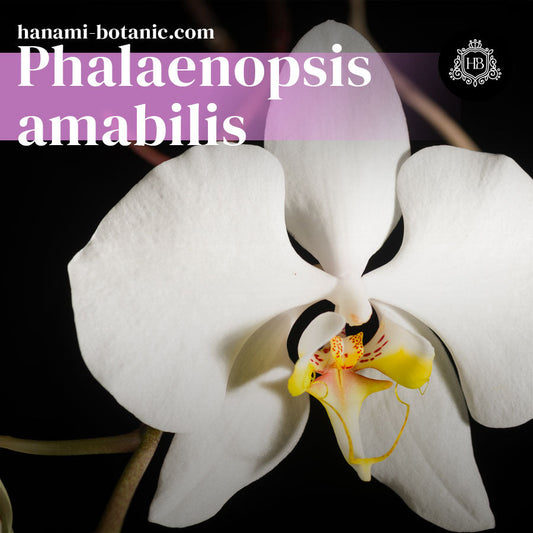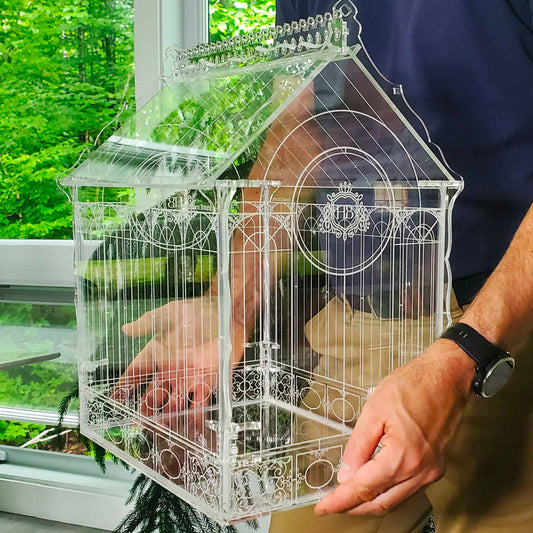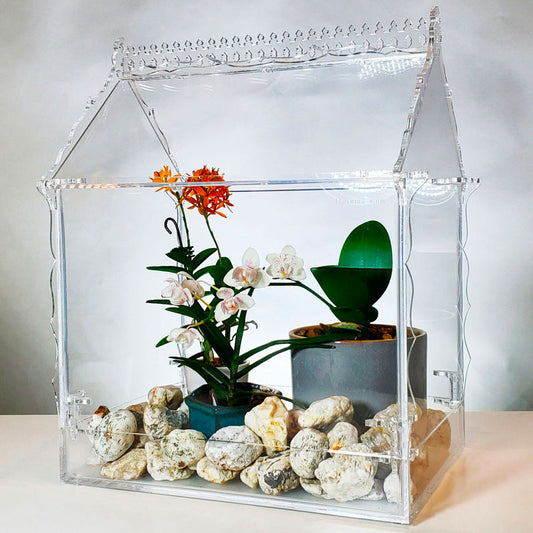Cattleya dowiana - Blooming and Care
Christian St-PierreCattleya dowiana, also known as the Golden Cattleya, is a striking orchid that captivates with its vibrant yellow flowers and deep magenta lips.
This orchid is cherished not only for its beauty but also for its enchanting fragrance, making it a favorite among collectors.
Why do we love it? It's the combination of its striking colors, delightful scent, and the challenge it presents to orchid enthusiasts that makes Cattleya dowiana truly special.

Where to buy Cattleya dowiana?Although this orchid can be challenging to find, it is sometimes available on specialized sites. You can check these sources to find Cattleya dowiana:
Check these sites regularly to add this beautiful orchid to your collection. |
Origin and history
Cattleya dowiana hails from the tropical rainforests of Costa Rica and Panama, where it thrives in the humid, warm climate.
Discovered in the mid-19th century, this orchid has become a symbol of elegance and beauty in the orchid world.
Its name honors John Melmoth Dow, an orchid collector who was instrumental in bringing this stunning species to the attention of the botanical community.
How to grow Cattleya dowiana: Care guide
Summary
- Scientific Name and Family: Cattleya dowiana, Orchidaceae
- Type of Plant: Epiphytic orchid
- Light: Bright, indirect light
- Day/Night Temperature: 25-30°C (77-86°F) during the day, 18-20°C (64-68°F) at night
- Watering: Regularly, allowing the medium to dry slightly between waterings
- Humidity: 60-80%
- Substrate: Well-draining orchid mix
- Fertilization: Regularly during the growing season with a balanced orchid fertilizer
- Growth: Moderate, with blooming typically occurring in late summer

How to reflower Cattleya dowiana
Reflowering Cattleya dowiana requires creating a significant temperature difference between day and night, a method known as "thermal oscillation."
While many believe fertilization is the key to reflowering, it's actually this temperature variation that triggers the flowering process.
Light is also crucial; provide bright, indirect light to mimic its natural habitat. Personally, I use specific LED grow lights designed for orchids, ensuring they receive the optimal light spectrum needed for blooming.
Varieties and similar plants
Explore other varieties of Cattleya and similar orchids, such as:
These varieties share similar growing conditions and are equally captivating.
FAQ about Cattleya dowiana
FAQ // Does one absolutely need an orchidarium or a Wardian case to grow a Cattleya dowiana?
No, it is not absolutely necessary to use an orchidarium or a Wardian case to grow a Cattleya dowiana, but it can significantly enhance its growth and blooming. Cattleya dowiana is a bit particular about its environment, and a controlled setting can provide the perfect conditions for it to thrive.
An orchidarium or Wardian case offers high humidity, stable temperatures, and ample light—all essential for this orchid's health. In a typical indoor setting, it is important to maintain high humidity levels, provide bright but indirect light, and ensure good air circulation while protecting the orchid from cold drafts. The dry air from home heating systems can be tough on Cattleya dowiana, making an enclosed environment like a Wardian case very beneficial.
I design Victorian-style Wardian cases that not only meet the needs of delicate orchids like Cattleya dowiana but also serve as beautiful decorative pieces. These cases provide a controlled microclimate, making it easier to care for your orchids and ensuring they get the best possible conditions. Feel free to check out my current models at Hanami Botanic, and I'm always open to suggestions and feedback!
Discover my handcrafted Wardian Cases
FAQ // Is Cattleya dowiana difficult to maintain?
It requires specific care, but with the right conditions, it can thrive. Consistent temperature and humidity control are key.
FAQ // How do I care for a Cattleya dowiana orchid?
Provide bright, indirect light, maintain humidity at 60-80%, water regularly, and use a well-draining orchid mix. Fertilize during the growing season with a balanced orchid fertilizer.
FAQ // What kind of light does Cattleya dowiana prefer?
Cattleya dowiana thrives in bright, indirect light. This orchid needs ample light to produce its stunning flowers, but direct sunlight can be too intense and may scorch the leaves. Here’s how to provide the optimal lighting conditions:
Natural Light: Place your Cattleya dowiana near an east or west-facing window where it can receive gentle morning or afternoon light. If you use a south-facing window, make sure to filter the light with sheer curtains to avoid direct sun exposure.
Light Intensity: Aim for light levels of around 20,000 to 30,000 lux. You can measure this with a light meter to ensure your orchid is getting the right amount of light.
Artificial Light: If natural light is insufficient, you can supplement with artificial grow lights. Full-spectrum LED lights are ideal, as they provide a balanced spectrum that mimics natural sunlight. Position the lights about 12-18 inches above the orchid and run them for about 12-14 hours a day.
Maintaining the right light conditions is crucial for the health and blooming of your Cattleya dowiana. By providing bright, indirect light, you’ll help your orchid thrive and produce its beautiful flowers.
FAQ // What is the best method for watering Cattleya dowiana?

The best method for watering Cattleya dowiana is to ensure that the plant receives consistent moisture without becoming waterlogged. This orchid prefers a wet-dry cycle, where the roots are allowed to dry slightly between waterings. Here are some effective watering methods:
Soaking Method:
- Description: Place the orchid pot in a container of water so that the water reaches about halfway up the pot. Let it soak for 10 to 15 minutes.
- Advantages: Ensures thorough hydration of the roots without oversaturating the medium.
- Disadvantages: Make sure to let the pot drain completely to avoid root rot.
Overhead Watering:
- Description: Slowly pour water over the medium until it is thoroughly wet. Ensure excess water drains out of the pot.
- Advantages: Allows for easy control of the water amount and ensures even distribution.
- Disadvantages: Requires attention to prevent water from accumulating in the saucer.
Immersion Watering:
- Description: Fully submerge the pot in a container of water for a few minutes, then allow it to drain thoroughly.
- Advantages: Provides quick and complete hydration to the roots and medium.
- Disadvantages: Can be less practical for large collections of orchids.
Watering Frequency:
- Water Cattleya dowiana when the top inch of the potting medium feels dry. Typically, this means watering about once a week, but frequency can vary based on environmental conditions.
Water Quality:
- Use distilled water, rainwater, or reverse osmosis water to avoid mineral buildup that can harm the roots.
Additional Tips:
- Ensure the pot has excellent drainage to prevent stagnant water, which can cause root rot.
- During the growing season (spring and summer), keep the medium more consistently moist. In the dormant season (fall and winter), allow for a bit more drying between waterings.
By following these methods and tips, you can keep your Cattleya dowiana healthy and thriving, promoting beautiful blooms and vigorous growth.
Detailed Care Guide for Cattleya dowiana
Type of Plant
Cattleya dowiana is an epiphytic orchid, naturally growing on trees in its native habitat.
Light
Bright, indirect light is ideal. I use LED grow lights specifically designed for orchids, providing the necessary light spectrum without the risk of scorching the leaves.
Temperature
Maintain daytime temperatures between 25-30°C (77-86°F) and nighttime temperatures between 18-20°C (64-68°F) to mimic its natural environment.
Watering
Water regularly, allowing the medium to dry slightly between waterings. Be cautious of overwatering, which can lead to root rot.
Humidity
Keep humidity levels between 60-80%. I use a humidifier in my growing area to maintain these levels, especially during the dry winter months.
Substrate
A well-draining orchid mix is essential. I recommend a mix of bark, perlite, and sphagnum moss.
Fertilization
For Cattleya dowiana, I use a specific orchid fertilizer, such as the MSU (Michigan State University) formula. This provides a balanced nutrient mix, promoting healthy growth and vibrant blooms.
- MSU Fertilizer: Optimal balance of essential nutrients
- Water pH: Maintain between 5.5-6.5 for nutrient absorption
- Silicon: Strengthens plant cells, enhancing resistance to disease
- Fresh seaweed: Natural source of micronutrients and phytohormones
- Superthrive: Vitamin supplement to reduce plant stress and stimulate growth
These products, used together, create an ideal nutritional environment for Cattleya dowiana, ensuring robust growth and spectacular blooms.
Growth
Cattleya dowiana grows moderately, with blooms typically appearing in late summer. Consistent care and the right conditions will reward you with its stunning flowers and captivating fragrance.

I'm Christian. Passionate about orchids and terrariums for many years, I share my botanical adventures, practical advice, and personal anecdotes. I also create terrarium-style mini greenhouses to help your orchids thrive. Feel free to contact me—I’d be happy to help you on this beautiful botanical journey.
References
Conclusion
I hope this detailed guide on Cattleya dowiana inspires you to enrich your orchid collection and explore the wonders of growing plants in mini-greenhouses.












